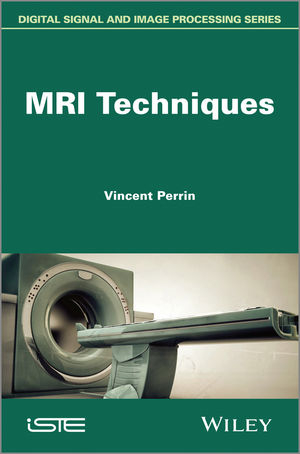
MRI Techniques
ISTE Ltd and John Wiley & Sons Inc (Verlag)
978-1-84821-503-0 (ISBN)
The rapid developments in magnetic resonance imaging (MRI) over the past 20 years have affirmed its supremacy over most other means of non-invasive exploration of the human body. This progress has had other consequences for imaging physicists: having knowledge about only one of the sides of MRI is nowadays no longer enough to develop new sequences or even to learn more about those that already exist. It is necessary to have a clear and precise view of all the fields explored today by this imaging technique, such as rapid imaging, flows, diffusion, perfusion or even functional MRI.
This book aims to allow readers with the basics of physics and mathematics within the field MRI to easily immerse themselves in techniques that are not familiar to them. Pragmatic in approach, moving between the physics underlying the techniques being studied and the clinical examination of images, it will also be of interest to radiologists looking to define protocols or make better use of the images obtained.
Contents
1. Flow.
2. Diffusion.
3. Perfusion.
4. Functional MRI.
About the Authors
Vincent Perrin is a specialist teacher in the fields of physics and chemistry.
Vincent Perrin is Associate Professor, Poissy, France.
Chapter 1. Flow 1
1.1. Blood 1
1.1.1. Characteristics of bloodflow 1
1.1.2. Laminar flow and turbulent flow 2
1.2. Basic phenomena in angiography 3
1.2.1. Time of Flight (TOF) 3
1.2.2. Phenomenon of dephasing of circular spins 8
1.3. Artifacts relating to the flow 11
1.3.1. Artifact of pulsatile flow of blood or cerebrospinal fluid (CSF) 11
1.3.2. Fluid location error 14
1.3.3. Other artifacts 18
1.4. MRA sequences 20
1.4.1. Time of Flight (TOF) 20
1.4.2. Phase-contrast angiography (PCA) 29
1.4.3. The “match” between TOF and PCA imaging 36
1.4.4. Contrast-enhanced MRA (CE-MRA) 37
1.5. Study of two clinical problems 45
1.5.1. Differentiation between a thrombus and a slow flow 45
1.5.2. “Correct” evaluation of a stenosis 47
Chapter 2. Diffusion 49
2.1. General points 49
2.1.1. What is diffusion? 49
2.1.2. What is the medical interest held by diffusion? 50
2.1.3. The three main types of diffusion 50
2.2. Principle behind diffusion imaging and the associated sequence 51
2.3. Study of the obtained signal 53
2.3.1. Expression of the signal 54
2.3.2. Diffusion coefficient 57
2.3.3. The b factor 58
2.4. Diffusion sequence and diffusion images 59
2.4.1. Complete sequence 60
2.4.2. Diffusion image 60
2.4.3. Apparent Diffusion Coefficient (ADC) maps 65
2.4.4. Pitfall images 68
2.5. The different clinical applications for diffusion 70
2.5.1. Study of an ischemic accident 70
2.5.2. Cerebral abscess or necrotic tumor? 76
2.5.3. Limitations of diffusion imaging 77
2.6. Artifacts frequently encountered in diffusion 79
2.6.1. Artifact specific to EPI 79
2.6.2. Artifact peculiar to the diffusion sequence 80
2.7. Diffusion-tensor imaging 82
2.7.1. Advantage 82
2.7.2. General principles of diffusion tensor imaging (DTI) 84
2.7.3. Diffusion tensor imaging 89
2.7.4. Clinical applications 95
2.8. Tractography 96
2.8.1. FACT method 97
2.8.2. Two important parameters in this method 99
2.8.3. The problem of crossed fibers 100
2.8.4. Clinical applications 101
Chapter 3. Perfusion 103
3.1. General points 103
3.1.1. What is perfusion? 103
3.1.2. What is the medical advantage to perfusion? 104
3.2. Exogenous tracers 105
3.2.1. Technique 105
3.2.2. Information obtained with a perfusion sequence 106
3.2.3. Alteration of the parameters as a function of the type of disease 109
3.2.4. Optimization 110
3.3. Endogenous tracers: ASL technique 111
3.3.1. Why use endogenous tracers? 111
3.3.2. Principle and sensitivity of the endogenous tracer method 111
3.3.3. Continuous Arterial Spin Labeling (CASL) 114
3.3.4. PASL (Pulsed Arterial Spin Labeling) technique 125
3.3.5. CASL or PASL? 130
3.3.6. Conclusion: advantages and limitations of ASL 131
3.4. Medical applications 133
3.4.1. Ischemic CVA 133
3.4.2. Tumors 137
3.4.3. Other applications 139
Chapter 4. Functional MRI 141
4.1. Introduction 141
4.2. Principle 141
4.2.1. Origin of fMRI signal (BOLD effect) 141
4.2.2. Type of paradigm 145
4.2.3. Type of sequence used in fMRI 149
4.3. Introduction to statistical analysis 150
4.3.1. Why this study? 150
4.3.2. How should this analysis be done? 152
4.3.3. Simple linear regression technique 153
4.3.4. Multiple linear regression technique 167
4.4. Statistical analysis and fMRI 176
4.4.1. Modeling of the fMRI signal 176
4.4.2. Statistical test 187
4.5. Pre-processing and limitations of fMRI 203
4.5.1. Motion correction 203
4.5.2. Correction of delay in acquisition between slices 209
4.5.3. Correction of geometrical distortions 210
4.5.4. Overall view of treatment in fMRI 210
4.6. Application of fMRI 212
4.6.1. Group analysis 212
4.6.2. Disease 217
Bibliography 221
Index 223
| Verlagsort | London |
|---|---|
| Sprache | englisch |
| Maße | 163 x 241 mm |
| Gewicht | 562 g |
| Themenwelt | Medizinische Fachgebiete ► Radiologie / Bildgebende Verfahren ► Kernspintomographie (MRT) |
| Technik ► Umwelttechnik / Biotechnologie | |
| ISBN-10 | 1-84821-503-7 / 1848215037 |
| ISBN-13 | 978-1-84821-503-0 / 9781848215030 |
| Zustand | Neuware |
| Informationen gemäß Produktsicherheitsverordnung (GPSR) | |
| Haben Sie eine Frage zum Produkt? |
aus dem Bereich


